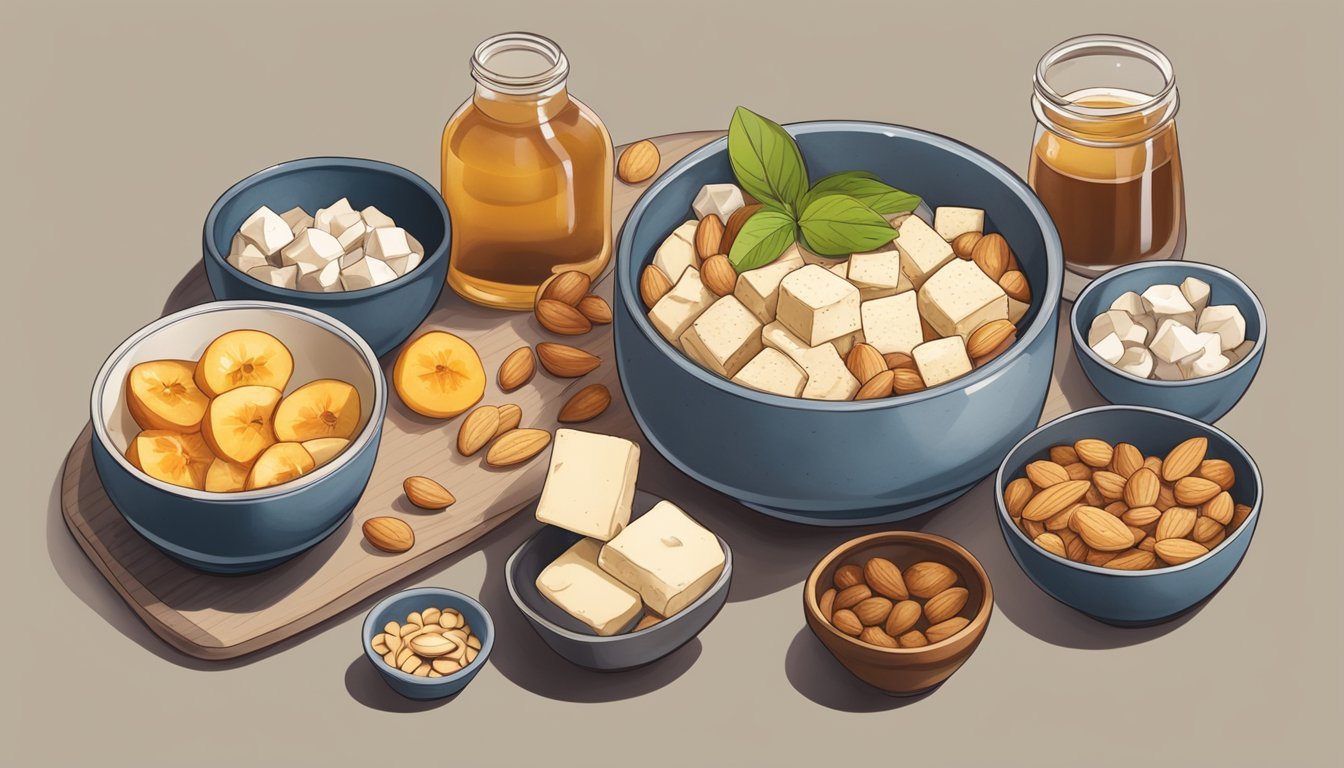How do you eat Xingren Doufu:
A Guide to Enjoying Almond Tofu
Xingren doufu, also known as almond tofu, is a popular dessert of Chinese origin that has charmed the taste buds of people across East Asia. Its delicate, soft texture and distinct almond flavor make it an endearing treat among a variety of desserts (What wine goes well with desserts?). Commonly likened to a form of jelly or pudding, almond tofu is made from apricot kernel milk, which imparts a subtle almond essence, combined with sweetening agents and a setting agent like agar or gelatin to achieve its trademark consistency.
The preparation of almond tofu involves dissolving the setting agent in water or milk, then blending it with sugar and almond extract or apricot kernel milk to infuse the flavor. Once the mixture is thoroughly combined, it's poured into molds to set, usually refrigerated until it attains a firm, silky structure. Traditionally, the dessert is then served chilled, often accompanied by fruit syrups or fresh fruits, with its snowy-white appearance making it as visually appealing as it is delightful to eat.
Consuming almond tofu can vary from one region to another, but it is typically enjoyed as a refreshing finale to a meal, especially in warmer climates due to its cool, soothing nature. It can also be seen gracing the tables at festive events and family gatherings, adorned with toppings such as lychee, longan, or with a drizzle of sweet osmanthus syrup, enhancing the dessert’s delicate almond flavor and adding layers of texture.
Historical Background
杏仁豆腐, or almond tofu, is a Chinese dessert with a rich historical tapestry that began in China. This dessert is characterized by its soft, jelly-like texture and is traditionally made from apricot kernel milk, agar, and sugar. As a dessert that reflects the sophistication of Chinese cuisine, almond tofu has been savored not only within its country of origin but also across various neighboring regions, such as Hong Kong and Japan, where it is known as annin tofu.
In China, almond tofu is commonly served chilled, often as a refreshing end to a meal. The use of apricot kernel milk imparts a subtle almond flavor, while agar—a plant-based gelatin derived from seaweed—provides its quintessential gentle wobble. Over time, almond tofu found its way into the hearts of people across other East and Southeast Asian countries, becoming a well-loved Asian dessert.
The dessert’s spread across Asia can be attributed to both cultural exchange and the migration of Chinese diaspora, taking their culinary expertise and traditions with them. In regions like Hong Kong and Japan, it has been adapted and embraced, merging seamlessly into the local dessert cultures. This has led to interesting regional variations in the recipe and presentation of almond tofu, illustrating the versatility and appeal of this sweet treat.
While the dessert is simple, its connection to centuries-old culinary traditions speaks to a history of innovation and cultural interaction, reflecting the essence of Asian gastronomy and its ability to cross cultural boundaries with grace.
Health Benefits and Dietary Information
Almond tofu, known in Mandarin as xingren doufu, is a dessert that traditionally aligns with vegan dietary preferences, as it is free from animal products. This dessert's main ingredients include almond milk or apricot kernel milk and a setting agent such as agar. Almond milk serves as a lactose-free, vegan-friendly alternative to dairy milk, providing nutritional value including vitamins, minerals, and healthy fats.
Nutritional Content of Almond Tofu:
Protein: Almond tofu contains lower amounts of protein compared to soy products. However, it can still contribute to the daily protein requirements.
Fats: Almonds are a good source of monounsaturated fats, which are beneficial for heart health.
Vitamins and Minerals: Almonds are rich in vitamin E, magnesium, and calcium, especially when fortified almond milk is used.
The dessert is often sweetened, so those watching their sugar intake should be mindful. Variations made with soy milk may offer a higher protein content, making it an even more substantial snack or dessert option. As the dessert is often set using agar, a plant-based alternative to gelatin, it remains vegan-friendly while also offering the benefits of dietary fiber.
For individuals seeking to indulge in a sweet treat, xingren doufu offers a dessert with potential health benefits, especially when prepared with minimal added sugars. It does, however, offer less protein compared to traditional tofu, which is made from soybeans.
Please note that while almond tofu can be part of a balanced, vegan diet, it should be consumed in moderation due to its sugar content.
Key Ingredients
The creation of xingren doufu hinges on selecting the right key ingredients that meld together to form this delicate dessert. The balance of flavor and texture rests on these foundational components.
Almond Base
The almond base is the heart of xingren doufu. It traditionally involves almond extract or apricot kernel milk, which provides the distinctive almond flavor. Some recipes may substitute with almond milk for added richness.
Sweetening Agents
Sweetness in xingren doufu comes from sugar, often rock sugar which has a clean, unobtrusive sweetness. Osmanthus syrup is a popular choice in some recipes, contributing a floral note to the dessert.
Thickening Agents
Agar, gelatin, or agar powder, known as thickening agents, give xingren doufu its signature pudding-like texture. Agar is preferred for a firmer structure while gelatin lends a more jiggly consistency.
Additional Flavors
While the almond base is primary, additional flavors like matcha powder or osmanthus flowers can be infused to enhance the dessert’s taste profile.
Liquid Components
The liquid components such as milk, soy milk, or water are crucial for dissolving the sugar and mixing with the almond base. Cold water is often used to bloom gelatin or agar agar.
Dietary Variations
For dietary variations, vegan alternatives are available, replacing cow's milk with almond milk or soy milk and gelatine with vegan-friendly agar.
Garnishes and Add-ons
Garnishes such as fresh fruits, toasted nuts, or fruit cocktail add texture and flavor. Sliced fruit or canned fruits are commonly used to top xingren doufu before serving.
Preparation Techniques
The art of making Xingren Doufu, also known as almond tofu, involves a series of precise steps to achieve its signature creamy texture. The process requires careful attention to mixing and blending of ingredients, the right choice of coagulators for firming the dessert, and proper cooling for it to set.
Mixing and Blending Methods
To start, they blend almonds with water to create a creamy almond milk. This liquid is the base of the dessert. Prep time for this stage can vary, but one should allocate around 30 minutes for soaking and blending the almonds. The almond base should be smooth with no lumps, ensuring a refined creamy texture.
Coagulation and Firming
A coagulator, such as agar or gelatin, is essential for the dessert to set and achieve the right firmness. The mix of almond milk and coagulator is then heated until the coagulator dissolves completely, which could take about 10 minutes. It's important to heat the mixture just until it reaches firming temperatures, as overheating can affect the texture.
Cooling and Settling
After the mixture is fully combined, it's poured into molds and allowed to cool at room temperature. To ensure that it sets properly, refrigerating it for several hours is crucial. Total time from start to finish, including cook time and setting, might total a few hours.
Serving Suggestions
Xingren Doufu can be served on its own or with garnishing to enhance its flavor. Popular options include a light drizzle of honey or a sprinkle of roasted nuts. Servings are usually presented in small bowls or cups, each serving being just enough for one person to enjoy.
Presentation
The final touch to almond tofu is its presentation. It can be turned out onto a plate and surrounded with sliced fruit, such as peaches or lychee, to complement its delicate almond flavor. A well-presented serving of Xingren Doufu is not only a treat for the palate but also for the eyes.
Step-by-Step Recipe
Prep Time: 10 minutes
Cook Time: 20 minutes
Total Time: 30 minutes
Servings: 4
Ingredients:
1 ½ cups milk
½ cup heavy cream
1 tbsp almond extract
¼ cup sugar
Gelatin or agar (amount as per package instructions)
Optional toppings: sliced almonds, fresh fruits
Instructions:
Prepare Gelatin or Agar: If using gelatin, mix it with a small amount of cold water to bloom. For agar, soak in water before cooking.
Heat the Milk: In a saucepan, gently heat 1 ½ cups of milk. If using sugar, add it to the milk and stir until dissolved. Do not bring to a boil.
Combine Gelatin/Agar with Milk: Once the gelatin is bloomed or agar is partially dissolved after boiling, mix it into the warm milk until fully dissolved.
Add Flavor and Cream: Stir in the almond extract and heavy cream into the milk mixture until well combined.
Pour and Set: Pour the mixture into ramekins or a mold. Allow it to cool to room temperature, then refrigerate until set, about 2 hours.
Serve the almond tofu chilled, optionally garnished with sliced almonds or accompanied by fresh fruit to enhance the flavor.
Variations and Regional Specialties
Xingren doufu, or almond tofu, is a versatile dessert cherished across different regions, especially within China and Japan. Its texture, flavor profile, and accompaniments can vary widely, providing an array of specialties for every palate.
Almond Jelly Variations
China: In its homeland, annin tofu is traditionally served with a clear, sweet syrup and sometimes topped with fresh or canned fruits.
Japan: Here, the dessert takes on a firmer texture and may be served with a drizzle of osmanthus syrup or alongside matcha powder, enhancing its flavor profile.
Texture and Firmness Variations
Agar-Agar: A common ingredient in almond jelly, agar-agar results in a firmer texture compared to gelatin-based desserts like panna cotta or French blancmange.
Variations in Firmness: Depending on regional preferences, the firmness can range from soft and spoonable to a firmer, chewier bite akin to coffee jelly.
Flavor Variants
Classic: The classic flavor of almond tofu is mildly sweet with a pronounced almond essence.
Innovative pairs: Some chefs experiment by combining the almond base with other flavors, such as crème caramel or coconut, to create new taste experiences.
Vegan and Allergy-Friendly Options
Milk Alternatives: For those with dietary restrictions, almond milk or soy milk can replace dairy, while maintaining the dessert's signature almond flavor.
Agar Powder: Vegan-friendly and suitable for those with gluten allergies, agar powder is a perfect substitute for gelatin, allowing everyone to enjoy this dessert without compromise.
Serving and Pairing
Xingren doufu, also known as almond tofu, is a delicate and light dessert often enjoyed in Asian culinary traditions, particularly within Chinese cuisine. It is typically served chilled, making it a refreshing end to a meal.
Serving Suggestions:
Individual Portions: Present the almond tofu in small bowls or ramekins.
Family Style: Offer it in a larger dish, allowing diners to serve themselves.
Pairing with Fruits:
To enhance the sweetness and add a textural contrast, almond tofu can be paired with an assortment of fruits. A popular choice in Chinese restaurants is to top it with:
Lychee
Mandarin segments
Longan
Peaches
Texture and Flavor Enhancements:
Syrups: Drizzle with a light syrup or honey to increase sweetness, if desired.
Nuts: Sprinkle crushed almonds or other nuts on top for additional crunch.
Accompanying Beverages:
Almond tofu's subtle flavor pairs well with tea, balancing the dessert's sweetness:
Jasmine tea
Oolong tea
Green tea
Servings Tips:
For a pleasing presentation, consider garnishing with a sprig of mint or a dusting of ground almonds. One must pay attention to the balance between the almond tofu’s innate nutty sweetness and the accompaniments' flavors to neither overpower the dessert nor undermine its delicate taste profile.
Storage and Preservation
Proper storage of Xingren Doufu (almond tofu) is essential to maintain its delicate flavor and texture. After preparing or purchasing almond tofu, one should refrigerate it if not consumed immediately. The ideal temperature for storage is between 35°F to 38°F (1.7°C to 3.3°C).
When refrigerating:
Place the almond tofu in an airtight container. This will prevent it from absorbing odors from other foods and will also maintain the tofu’s moisture content.
Before sealing the container, one might consider lightly draping a piece of plastic wrap directly on the surface of the almond tofu to further protect against air exposure.
For extended storage beyond a couple of days, freezing almond tofu is not recommended as it can drastically alter the texture and make it undesirable.
In the event that a large batch of almond tofu has been made, it's practical to divide it into smaller portions before refrigerating. This ensures that only the necessary amount is removed when needed and reduces the risk of contaminating the entire batch.
Remember, almond tofu is best enjoyed fresh. It should typically be consumed within a few days of making or purchasing to experience its optimal taste and consistency. Always check for any signs of spoilage, such as an off smell or mold, before consumption and discard any almond tofu that appears compromised.
Common Mistakes to Avoid
When preparing Xingren Doufu (Almond Tofu), there are certain pitfalls one should steer clear of to ensure the dessert's quality in terms of texture, sweetness, and firming process.
Inconsistent Texture: The desired outcome for almond tofu is a smooth and soft consistency. Insufficient blending of the almond base can result in a gritty texture.
Solution: Thoroughly blend the almond mixture to a fine consistency, and strain it to remove any solid bits.
Over-sweetening: Almond tofu’s subtle flavor can be overrun by too much sugar.
Solution: Gradually add sugar, tasting as you go, to achieve a balanced level of sweetness.
Improper Firming Temperatures: This dessert needs to set at the right temperature to achieve the perfect firmness.
Solution: Refrigerate the mixture to set and avoid freezing, which can alter the texture.
Textural Issues
Use a fine sieve to strain the mixture and avoid lumps that compromise the dessert's gelatinous quality. The constituents should be dissolved completely before chilling.
Balance of Sweetness
One should remember the additive aspect of sweetness—once it's in the mixture, it cannot be taken out. Almond tofu is enjoyed for its delicate flavor, which should not be masked by excessive sugar.
Firming Process
Each gelating agent—whether agar or gelatin—requires specific handling and temperatures to set properly. Not adhering to these can result in either a runny dessert that never sets or one that's too stiff.
Gelating Agent Recommended Use Agar Dissolve completely in boiling water before combining with other ingredients. Gelatin Bloom in cold water, then dissolve in a warm base without boiling.
Almond tofu is a delicacy where the sumptuous enjoyment lies in its gentle nuances, thus one must pay careful attention to these particular areas to create an exquisite experience.
FAQs and Troubleshooting
Why isn't my almond tofu firming up?
Solution: The issue may lie with the firming agents or temperatures. For agar-based versions, it needs to boil properly—generally more than 10 minutes. As for gelatin, ensure that it's bloomed in cold water before dissolving in the hot mixture. Both require sufficient cooling to set, often at room temperature followed by refrigeration.
Is my almond tofu vegan-friendly?
Ingredient Check: Traditional xingren doufu recipes use gelatin, which is animal-derived. To make a vegan-friendly version, replace gelatin with agar, a plant-based alternative.
Why does my almond tofu taste plain?
Sugar Adjustment: Almond tofu's sweetness comes from sugar. If it's too bland, one may haven't added enough. They can dissolve additional sugar into a small amount of soy milk and mix it into the tofu before it sets.
My almond tofu isn't creamy. What went wrong?
Milk Choices: The creaminess of xingren doufu stems from the milk used. For a richer texture, try incorporating full-fat soy milk or add a touch of heavy cream if not adhering to a vegan diet.
Can I remake almond tofu that didn't set properly?
Re-Firming Process: If it hasn't set, they can reheat the mixture, ensuring the firming agent is fully dissolved. They may need to adjust the amount of agar or gelatin if the issue persists. It's crucial to cool it to the proper firming temperatures once more.
Conclusion
Almond tofu, with its delicate sweetness, has cemented itself as a cherished Chinese dessert that transcends regional palates. Traditionally, it serves as a cooling and refreshing treat, often enjoyed during warmer seasons. It is typically garnished with a light syrup or fruit to enhance its flavor.
Cultural Significance The dessert holds cultural significance, symbolizing purity and refinement in Chinese cuisine. The process of creating almond tofu reflects the meticulous nature of traditional dessert-making, showcasing the thoughtful integration of simple ingredients to yield a sophisticated result.
Serving Suggestions
Chilled: Served cold, it provides a soothing contrast on hot days.
Accompaniments: Commonly paired with fruits like lychee, peach, or mango.
Sweet Syrup: Drizzled with sweet syrup to accentuate its almond flavor.
Dietary Adaptations Dairy-free alternatives accommodate dietary restrictions, utilizing plant-based milks to ensure almond tofu remains inclusive.
Texture and Flavor It boasts a texture that is simultaneously smooth and substantial, a trait that elevates it above many gelatin-based desserts. The infusion of almond essence imparts a subtle, yet unmistakable depth, striking a balance that pleases both connoisseurs of traditional Chinese desserts and newcomers alike.
In essence, almond tofu encapsulates the essence of a dessert that is as elegant as it is satisfying, bridging generations and cultures through its simplicity and the shared experience of a sweet reprieve.











